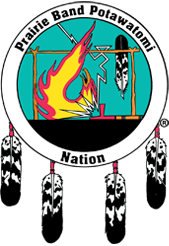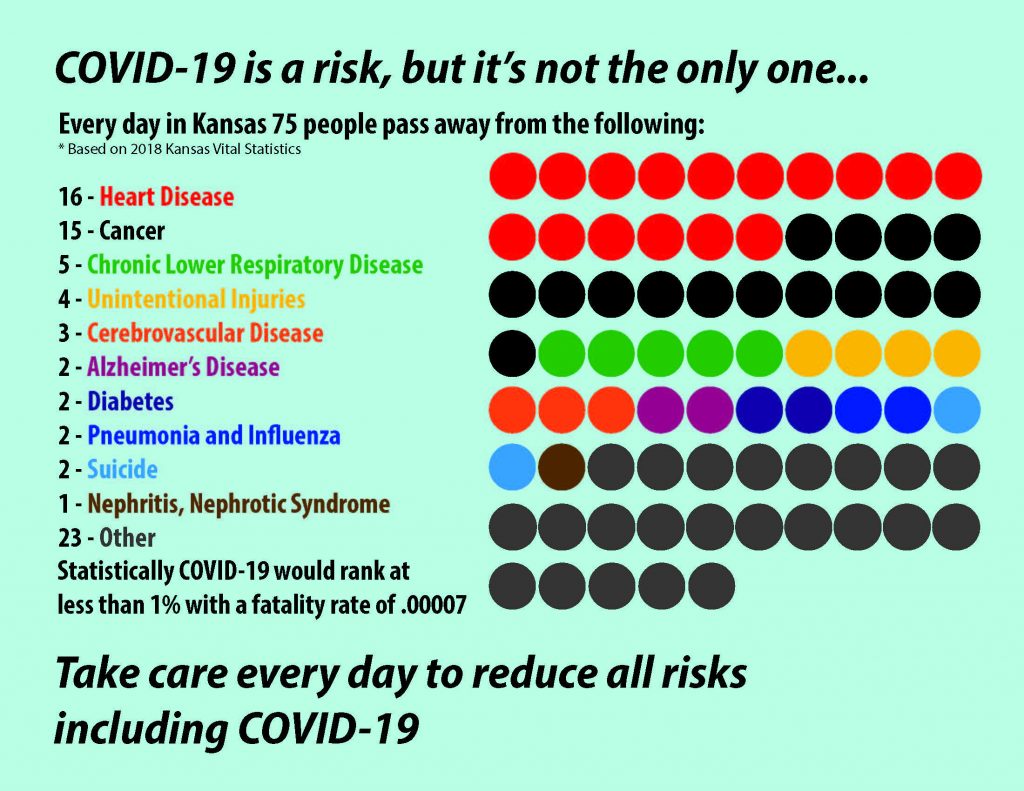6.4.20
COVID-19 and Our Community
With the first case of COVID-19 occurring on the Prairie Band Potawatomi Common Land, it is a natural outcome that you may experience feelings of anxiety or fear and likely have questions. To assist in making sense of the situation, let’s break it down.
COVID-19 In Context
The coronavirus pandemic has presented many unknowns and remains a real, and serious health condition. However, it is also important to frame the emotional toll of the situation in the context of factual data.
The CDC is currently reporting a fatality rate, the number of symptomatic individuals who pass away from COVID-19, at 0.004 based on current data and scientific knowledge. Within the state of Kansas 217 individuals have died from COVID-19, out of 2.913 million residents, which creates a fatality rate of .00007. Fatality from the disease is statistically highly unlikely.
As the data is scaled down to the local level, the rate increases but remains statistically low. As of June 1, Jackson County has reported 100 individuals that have tested positive, and one death.
For an individual to keep their immediate risk of contracting COVID-19 low, they should continue to practice social distancing, physical distancing, wearing masks, hand washing, and all other preventive measures.
PBPN Community Members
The Prairie Band Health Center and the Jackson County Department of Health are working together to do contact tracing. Staff from these programs are reaching out to people who may have come into contact with the positive individual. This would include anyone in the individual’s home along with anyone who was in proximity of fewer than 6 feet for more than 10 minutes.
The contact tracer will reach out to conduct an interview, asking questions to determine exposure and any signs of illness. Based on the exchange of information, an individual may be asked to isolate or quarantine, and to track the development of any symptoms. COVID-19 symptoms usually take 2-14 days to develop after being infected with the virus.
If an individual is experiencing symptoms and believed to be contagious, they should isolate or separate themselves from people who are not sick in their own residence.
If an individual is not experiencing symptoms, and not believed to be contagious, they should quarantine or restrict their interactions with the public for 14 days to monitor their symptoms and avoid exposing others.
Employees of the Prairie Band Potawatomi Nation government, along with visitors and vendors are required to self-respond to a screening questionnaire and take their temperature prior to gaining access to a tribal building. PBPN government employees should contact their supervisor if they have concerns or questions regarding exposure.
Limiting COVID-19 Spread
COVID-19, a novel coronavirus is mainly spread from person to person, primarily through respiratory droplets produced when an infected person coughs or sneezes. These droplets can land in the mouths or noses of people who are nearby or can possibly be inhaled into the lungs. Spread is more likely when people are in close contact with one another, less than 6 feet.
Preventive measures have shown they work to limit the spread of COVID-19.
Practicing social distancing by avoiding mass gatherings of people lowers your risk of contracting COVID-19. Limiting your time in large groups lessens the possibility of exposure.
Physical distancing of maintaining 6 feet or more from people helps deter the spread because you are out of reach of the droplets. This is especially important when going out into the general public, like at a gas station or grocery store.
Wearing a mask helps keep your own respiratory droplets to yourself. Respiratory droplets naturally occur while breathing, talking, sneezing, or coughing. Wearing a mask in public ensures you are not spreading droplets on others. Because COVID-19 can be asymptomatic, meaning you do not show any symptoms, it is a best practice to wear a mask at all times in public settings.
It may be possible that a person can get COVID-19 by touching a surface or object that has the virus on it and then touching their own mouth, nose, or eyes. Most people touch their faces “up to 16 times an hour,” according to a March 2020 Healthline Article.
Washing your hands frequently, with soap and water for 20 seconds or longer can help keep your hands clean of the virus and other germs. Using an alcohol-based sanitizer can also assist in keeping your hands clean, along with routinely cleaning high-touch surfaces in your home and workspace.
Additional Resources
– COVID-19 Symptoms
– COVID Do’s and Don’ts
– 5 Steps to Wash Your Hands
– Wear A Mask
– Fabric Mask Do’s and Don’ts
– Southern Plains Tribal Health Board
– Kansas Department of Health
– CDC – Center for Disease Control
- The Prairie Band Potawatomi Nation has a dedicated COVID-19 page – any posts made by the Nation involving COVID-19 can be found here. It is available by clicking COMMUNITY on the home page.

